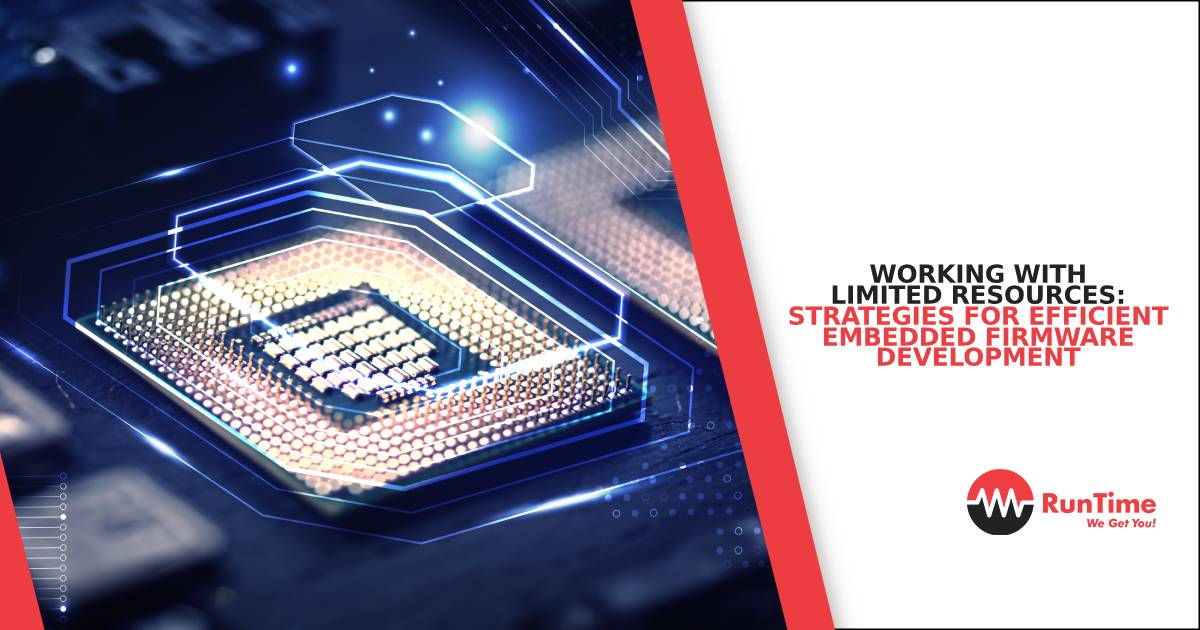Embedded systems are notorious for their stringent resource constraints, often operating with limited memory, processing power, and energy availability. These limitations challenge embedded engineers to devise innovative, efficient, and effective strategies for firmware development. This article explores various techniques and best practices that can help embedded developers optimize their firmware design, ensuring robust performance while adhering to the resource limitations inherent in many embedded environments.
Understanding the Constraints
Embedded systems are often deployed in environments where size, cost, and power consumption must be minimized. These constraints can severely limit the resources available for firmware development:
- Memory Limitations: Many embedded systems have only a few kilobytes of memory, which must accommodate both the program code and runtime data.
- Processing Power: Embedded processors, while highly efficient, may not offer the computational speed of more general-purpose CPUs, especially in low-cost or power-sensitive applications.
- Energy Efficiency: For battery-operated devices, conserving power is crucial. Firmware must be optimized to reduce energy consumption, extending battery life.
Strategies for Efficient Firmware Development
1. Optimize Data Handling
Efficient data management is crucial in resource-constrained systems. Optimizing how data is stored, accessed, and processed can significantly free up resources.
- Data Compression: Implementing data compression algorithms helps reduce the memory footprint, though developers must balance the memory saved against the additional processing overhead.
- Efficient Data Structures: Choose or design data structures that maximize efficiency for your specific application needs. For instance, bit fields can be used to store boolean flags compactly, and circular buffers are excellent for managing data streams.
2. Code Optimization
The way firmware is written can greatly affect both the size and speed of the embedded application.
- Function Inlining: Small, frequently called functions can be inlined to eliminate the overhead of function calls, although this may increase the code size.
- Loop Unrolling: This technique can speed up loops at the cost of increased program size. It is particularly useful when the loop iteration count is small and known at compile time.
- Conditional Compilation: Use preprocessor directives to include or exclude code based on compile-time conditions. This allows for the customization of firmware for different deployment scenarios without changing the source code.
3. Memory Management Techniques
Effective memory management is critical in embedded systems to prevent leaks and ensure stable operation.
- Static and Stack Memory Allocation: Whenever possible, use static or stack memory rather than dynamic memory allocation, which can lead to fragmentation and unpredictable behavior.
- Memory Pool Allocation: If dynamic allocation is necessary, consider using a memory pool allocator that divides memory into blocks of fixed size, simplifying management and improving allocation speed.
4. Utilize Compiler Optimizations
Leveraging the compiler’s optimization settings can help you achieve more efficient machine code.
- Optimization Flags: Explore the use of compiler optimization flags that can help reduce code size (-Os) or improve execution speed (-O2 or -O3), depending on your priorities.
- Custom Compiler Extensions: Some compilers offer extensions and pragmas that provide more granular control over optimizations like loop transformations and inlining behaviors.
5. Reduce Power Consumption
Reducing power consumption is essential for battery-operated devices and can also reduce heat and improve reliability.
- Duty Cycling: Implement duty cycling by periodically shutting down hardware components or the CPU itself when not in use.
- Dynamic Power Management: Use techniques such as varying clock speeds or shutting down unneeded peripherals to save power dynamically based on system activity.
6. Software and Hardware Co-design
Consider the hardware implications of software decisions and vice versa. Integrating software design closely with hardware design can lead to more efficient resource use.
- Hardware Acceleration: Utilize hardware accelerators for specific tasks like encryption or digital signal processing to offload these functions from the CPU.
- Peripheral Management: Efficiently manage peripherals and I/O operations, ensuring that they are active only when needed and properly configured to minimize power consumption and processing time.
7. Testing and Profiling
Regularly test and profile the firmware to identify bottlenecks and areas where resources are being inefficiently used.
- Profiling Tools: Use profiling tools to find hot spots in your code where most of the processing time is spent.
- Simulators and Emulators: These can be used to test the firmware under different conditions and with various resource constraints without needing physical hardware modifications.
8. Modular Design
Adopt a modular design approach to make better use of memory and simplify updates and maintenance.
- Functionality Segregation: Divide the application into distinct functional modules that can be independently developed, tested, and optimized.
- Reusable Code: Develop libraries of reusable code for common tasks across projects, which can reduce development time and ensure that optimized code is used consistently.
Conclusion
Efficient embedded firmware development requires a disciplined approach to resource management, a deep understanding of both hardware and software constraints, and the creativity to find the best solutions within these bounds. By adopting the strategies discussed, embedded engineers can develop applications that not only meet the stringent requirements of their operating environments but also deliver enhanced performance, reliability, and user experience. As technology continues to evolve, so too will the tools and techniques at the disposal of firmware developers, further empowering them to overcome the challenges posed by limited resources.









